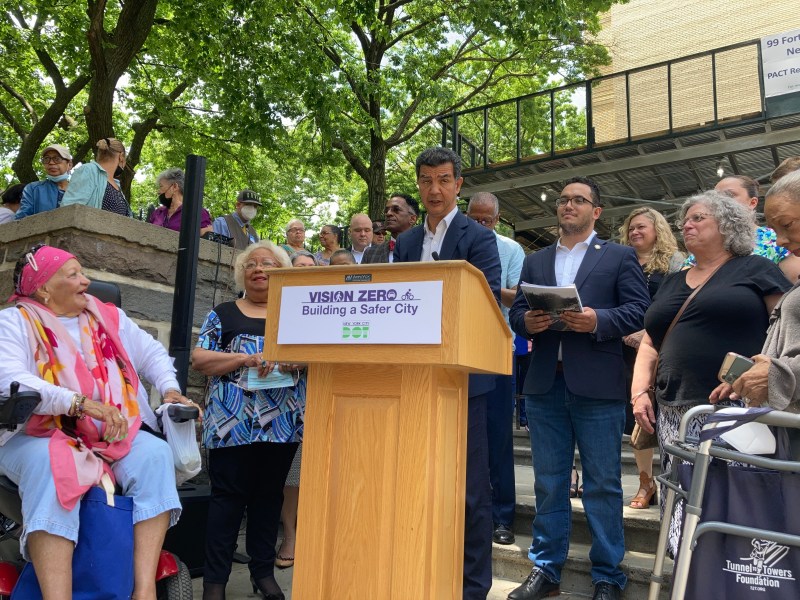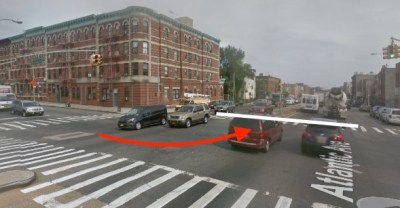Amid Senior Pedestrian Death Crisis, City Rolls Out Small Safety Initiative

The city will be safe for old people…well, someday.
The Department of Transportation on Tuesday unveiled a plan to make the city’s deadly streets safer for seniors, who are more likely to be victims of traffic violence relative to the population — but the effort to address the danger is as disproportionate to the problem as New Yorkers who are 65 or older are likely to get killed, advocates say.
DOT Commissioner Ydanis Rodriguez journeyed to the Outside Riverstone Senior Life Center in Washington Heights to announced that 50 intersections each year will get turn-calming treatments such as plastic bollards, rubber speed bumps, and paint markings to encourage drivers to slow down — but critics quickly did the math: with more than 40,000 intersections across the city, it would take at least 800 years to hit them at all.
“Fifty before the end of June sounds doable and serious,” said the account Second Avenue Sagas on Twitter. “Fifty a year sounds like pushing a boulder up a hill with a toothpick.”
50 before the end of June sounds doable and serious.
50 a year sounds like pushing a boulder up a hill with a toothpick.
— Second Ave. Sagas (@2AvSagas) June 14, 2022
When amNY reporter Kevin Duggan called out the snail’s pace at which DOT plans to protect seniors, Rodriguez defended the improvements, saying they are “data driven,” based on neighborhoods with high rates of senior injuries and fatalities.

“First of all, we are not saying we are doing every single intersection,” the commissioner said. “We are a data-driven administration. We are following the crashes. We are focusing on the most dangerous intersections.”
Yet according to that data, the very neighborhood in which DOT revealed its plans is excluded from those safety treatments because the city will target areas deemed “Senior Pedestrian Zones,” which have the highest rates of senior pedestrian injuries. Washington Heights didn’t make the cut.
Neither did anywhere on Staten Island, nor vast sections of Southeast Brooklyn, including Brighton Beach or Coney Island — both neighborhoods with large senior populations. (See map below.)
The new initiative is based on the results of a study, Pedestrian Safety and Older New Yorkers, which revealed that:
- Senior pedestrians are not struck more frequently, but their injuries are typically much more severe.
- Senior pedestrian fatalities are more likely to occur close to home.
- Senior pedestrians are often struck in the middle of the day.
- More seniors are injured and killed while riding their bike than by being struck by a cyclist.
Despite comprising less than 15 percent of the city’s population, New Yorkers who are 65 and up represent more than 45 percent of the total number of pedestrian fatalities each year, according to DOT.
And older Asian New Yorkers are killed in traffic violence at an even higher rate than Black, white and Latino New Yorkers, according to DOT, likely a result of densely populated older Asian communities in neighborhoods like Chinatown, Sunset Park, and Flushing, where more people walk than have a car.

To combat the deadly problem, in addition to the 50 intersections each year, Rodriguez said DOT also plans to expand and extend Leading Pedestrian Intervals mid-day in the Senior Pedestrian Zones by the end of 2024, implement at least 10 so-called Senior Street Improvement Projects each year, and target areas with high rates of older pedestrians for improvements like raised crosswalks.

Fatal crashes involving seniors are a persistent problem in New York City — and were so before Mayor Adams was sworn in in January, yet his predecessor, Mayor de Blasio, never attempted to boldly tackle the issue, except for cops giving some seniors reflective tape to put on their canes so drivers would not hit them.
So advocates are hailing the first small, yet still crucial, step towards protecting the city’s older population.
“Keeping older New Yorkers safe from traffic violence must be a priority for our city’s leaders” said Families for Safe Streets Member Irma Rosenblatt, whose 88-year-old mother was killed by a speeding SUV driver in 2014. “Crossing the street should not be a life-or-death endeavor but it often is for those who are most vulnerable. Today’s announcement from DOT to invest in safe streets improvements will help keep all New Yorkers safe especially older New Yorkers.”
And the city DOT redesigns far more than just 50 intersections per year, the agency pointed out. Tuesday’s announcement was simply about a limited initiative in neighborhoods with high numbers of seniors.
After initial publication of the story, the headline was updated to clarify the scale of the program.
